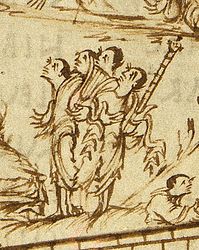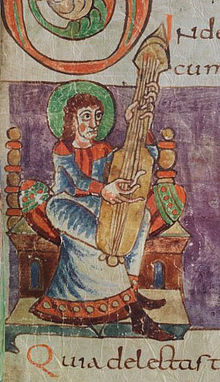 Two instruments that can be identified as a cythara. At left a cithara as lyre, on the right another type cythara, with a neck and frets. From the Utrecht Psalter, Psalm 145–146: "psallite Deo nostro in cithara" ("sing to our God upon the harp.") The manuscript is from the 9th century, but the images are thought to be copied from an earlier manuscript. | |
| String instrument | |
|---|---|
| Classification | Plucked string instrument |
| Hornbostel–Sachs classification | 321.32 (necked lutes) (Chordophone instrument in which the handle is attached to, or carved from, the resonator, like a neck) |
| Developed | c. 7th to 9th century |
| Related instruments | |
The cythara is a wide group of stringed instruments of medieval and Renaissance Europe, including not only the lyre and harp but also necked, string instruments.[1] In fact, unless a medieval document gives an indication that it meant a necked instrument, then it likely was referring to a lyre. It was also spelled cithara or kithara and was Latin for the Greek lyre.[1] However, lacking names for some stringed instruments from the medieval period, these have been referred to as fiddles and citharas/cytharas, both by medieval people and by modern researchers. The instruments are important as being ancestors to or influential in the development of a wide variety of European instruments, including fiddles, vielles, violas, citoles and guitars. Although not proven to be completely separate from the line of lute-family instruments that dominated Europe (lute, oud, gittern, mandore), arguments have been made that they represent a European-based tradition of instrument building, which was for a time separate from the lute-family instruments.

In the 9th century, one of the instruments that cythara was actively used to name was a large plucked or strummed instrument; pictures show it being played with a plectrum.[2] Pictures of the instrument illustrated in the Stuttgart Psalter all have the word "cythara" near the instrument in the text.[2] The players hold the instrument in a distinct manner similar to the way that citole players were shown to hold their instruments, resting the instrument on the playing arm, and bringing their forearm and wrist to the strings from underneath the body of the instrument. In contrast, players of lute family instruments, such as the gittern, mandore, or lute did not hold the instrument this way. Instead of keeping their arms below the instrument, they allowed their arm and wrist to move parallel to the soundboard, as a guitar player does today.
One picture in the Stuttgart Psalter of the cythara shows it held a different way from all the other pictures on that document. The player is holding it vertically, resting on his lap or knee, supporting the neck with his left hand and having a free right hand to play. Citole players have also been shown holding their instruments vertically.[3]
The name may have been popular for its "magical" connotations, a belief that the music from a stringed instrument could sway listeners emotions.[1] Lyres were displaced in medieval times by "plucked fiddles" (such as the guitar fiddle), which were solely plucked and strummed until the bow arrived in the 10th century.[1] The remaining lyres as well as the fiddles were adapted to fit the bow, after its arrival.[1] One example of an early bowed fiddle was the Byzantine lyra; an example of a bowed lyre that survived until modern times is the crwth.
- ^ a b c d e Segerman, Ephraim (April 1999). "A Short History of the Cittern". The Galpin Society Journal. 52: 106–107. doi:10.2307/842519. JSTOR 842519.
- ^ a b Ciabattoni, Francesco (15 January 2015). Dante's Journey to Polyphony By Francesco Ciabattoni. ISBN 9781442620230.
- ^ Rault, Christian. "plate4.jpg". christianrault.com. Retrieved 2 December 2016.
© MMXXIII Rich X Search. We shall prevail. All rights reserved. Rich X Search


